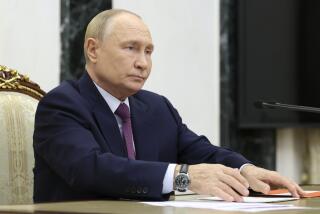Clinton Orders Revised Nuclear Weapon Policy
- Share via
WASHINGTON — President Clinton has ordered adoption of a revised U.S. policy statement on nuclear weapons that explicitly scraps the Cold War’s central emphasis on the threat from the former Soviet Union while laying new stress on the danger posed by rogue states such as Iraq.
After more than a half-year’s study, Clinton has signed a new version of the “presidential decision directive” that instructs the secretary of Defense and the Joint Chiefs of Staff on how to target the military’s nuclear weapons.
While the document has been revised several times since the fall of the Soviet Union, this is the first full rewriting of the directive signed by President Reagan in 1981. The Reagan and Bush administrations had also revised the document to reflect the easing of Cold War tensions.
While the new directive calls on the Pentagon to maintain its capability to strike military, civilian and nuclear sites in Russia, its guidance may lead the military to add to the list of potential nuclear target sites in China and the so-called rogue nations of Iraq and Libya.
*
Perhaps most significantly, Clinton’s directive for the first time shifts U.S. nuclear strategy from an emphasis on how to wage a protracted nuclear war to a plan for how to deter the use of nuclear weapons. At the same time, the directive is notable for language that would allow the United States to launch nuclear weapons in response to the use of chemical or biological weapons by enemy nations, a senior administration official said.
The new document “updates our nuclear policy to reflect the new world conditions,” the official said. Those changes include the fall of the Soviet Union and the rising threats posed by rogue nations, including the potential use of chemical and biological weapons, the official said.
Word of the new document comes at a time when the administration is looking toward a new round of arms-control talks, and when Russian President Boris N. Yeltsin has signaled his interest in further reducing the two countries’ strategic nuclear arsenals.
The careful and secretive drafting of the new policy statement may be a signal of the administration’s willingness to move ahead to a new round of talks concerning the Strategic Arms Limitation Treaty, although the official denied that it was intended as the basis for new negotiations.
To the extent that the directive opens the door for further arms reductions--in theory, an end to preparations for a protracted nuclear war would mean the U.S. would need to hold fewer weapons in reserve--the new policy could bring denunciations from some conservative leaders in Congress.
*
Arms-control advocates, meanwhile, are likely to call the new directive an inadequate response to the end of the Cold War because it continues a heavy emphasis on the U.S. nuclear arsenal.
Language regarding the threat of rogue nations and their chemical and biological weapons may also be intended as a signal to countries like Iraq that the United States could use nuclear weapons, at least in certain circumstances, if U.S. officials believe that the security of the nation is at stake, analysts said.
The United States has maintained a certain “studied ambiguity” on the question of under what circumstances it would use nuclear weapons in case of such a threat, said Stephen A. Cambone, a senior fellow at the Center for Strategic and International Studies in Washington.
The policy document is a conceptual one and gives no explicit directions to the armed forces on the deployment of strategic nuclear weapons or troops. During the next several months, the military staff of the Strategic Command, based in Omaha, will translate the document’s broad policy directives into specific targets and plans for striking them.
A spokesman for the National Security Council declined to discuss the new directive.
More to Read
Sign up for Essential California
The most important California stories and recommendations in your inbox every morning.
You may occasionally receive promotional content from the Los Angeles Times.













